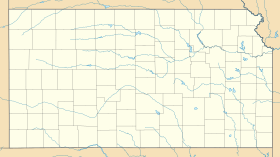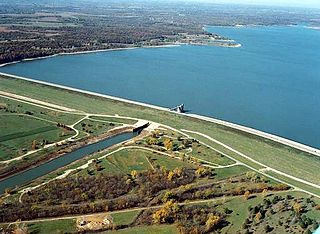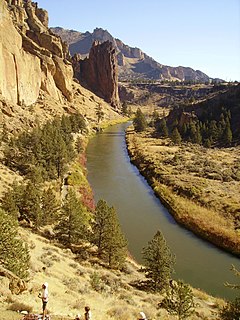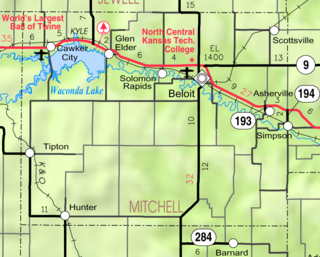| Cedar Bluff State Park | |
| Kansas State Park | |
Limestone on the edge of Cedar Bluff | |
| Country | |
|---|---|
| State | |
| County | Trego County, Kansas |
| Elevation | 2,185 ft (666 m) [1] |
| Coordinates | 38°48′41″N99°43′57″W / 38.81139°N 99.73250°W Coordinates: 38°48′41″N99°43′57″W / 38.81139°N 99.73250°W [1] |
| Area | 850 acres (344.0 ha) |
| Established | 1962 |
| Management | Kansas Department of Wildlife, Parks and Tourism |
| Website: Cedar Bluff State Park | |
Cedar Bluff State Park is a public recreation area located 21 miles (34 km) southeast of WaKeeney and 23 miles (37 km) southwest of Ellis in Trego County, Kansas, United States.

WaKeeney is a city in and the county seat of Trego County, Kansas, United States. As of the 2010 census, the city population was 1,862.

Ellis is a city in Ellis County, Kansas, United States. As of the 2010 census, the city population was 2,062.

Trego County is a county located in the U.S. state of Kansas. As of the 2010 census, the county population was 3,001. Its county seat and largest city is WaKeeney.
Contents
The state park is divided into two areas, comprising 850 acres (340 ha), straddling the 6,800-acre (2,800 ha) Cedar Bluff Reservoir. The Bluffton Area—300 acres (120 ha) on the north shore—is the most developed and receives extensive use. The Page Creek Area—500 acres (200 ha) on the south shore—offers primitive camping as well as 36 utility sites. [2] West of the Page Creek Area are the juniper-lined, 100-foot-tall (30 m) limestone bluffs from which the reservoir's name was derived (junipers were often misidentified as "cedars" by early settlers).

State parks are parks or other protected areas managed at the sub-national level within those nations which use "state" as a political subdivision. State parks are typically established by a state to preserve a location on account of its natural beauty, historic interest, or recreational potential. There are state parks under the administration of the government of each U.S. state, some of the Mexican states, and in Brazil. The term is also used in the Australian state of Victoria. The equivalent term used in Canada, Argentina, South Africa and Belgium, is provincial park. Similar systems of local government maintained parks exist in other countries, but the terminology varies.

Cedar Bluff Reservoir is a reservoir in Trego County, Kansas, United States. Built and managed by the U.S. Bureau of Reclamation for irrigation and area water supply, it is also used for flood control and recreation. Cedar Bluff State Park is located on its shore.
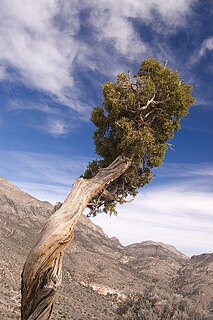
Junipers are coniferous plants in the genus Juniperus of the cypress family Cupressaceae. Depending on taxonomic viewpoint, between 50 and 67 species of junipers are widely distributed throughout the Northern Hemisphere, from the Arctic, south to tropical Africa, from Ziarat, Pakistan, east to eastern Tibet in the Old World, and in the mountains of Central America. The highest-known juniper forest occurs at an altitude of 16,000 ft (4,900 m) in southeastern Tibet and the northern Himalayas, creating one of the highest tree-lines on earth.
Threshing Machine Canyon, the site of an 1850s Native American attack on a wagon train bearing a threshing machine, is accessed by a road west of the park. In the historic canyon one can find carvings dating back to the mid-19th century. [3]

A threshing machine or thresher is a piece of farm equipment that threshes grain, that is, it removes the seeds from the stalks and husks. It does so by beating the plant to make the seeds fall out.

A canyon or gorge is a deep cleft between escarpments or cliffs resulting from weathering and the erosive activity of a river over geologic timescales. Rivers have a natural tendency to cut through underlying surfaces, eventually wearing away rock layers as sediments are removed downstream. A river bed will gradually reach a baseline elevation, which is the same elevation as the body of water into which the river drains. The processes of weathering and erosion will form canyons when the river's headwaters and estuary are at significantly different elevations, particularly through regions where softer rock layers are intermingled with harder layers more resistant to weathering.

